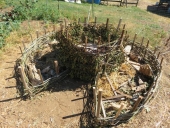From what I remember Roman concrete also requires hydraulic pressure as it was a technique developed originally from rammed earth. Supposedly the story goes that they were building a wall in Pozzuoli using rammed earth which they would cover in lime plaster to keep it from weathering, and the lime reacted with the Volcanic ash in the soil. So a lot of the structures still used that technique of rammed earth just with roman cement instead of soil. In fact theirs a number of different recipes using different pozzolana that were used in construction from crushed fired clay to grain hulls. So my recommendation is if your looking for an alternative building material I'd look at stabilized rammed earth or CEB's and if you don't have soils rich in pozzolana their are modern pozzolana that can be imported and used such as fly ash, steel slag, metakaolin, rice hulls, diatomaceous earth, etc. Each has their own properties so some investigation might be warranted, but if you live in a region that produces any of them then you may be able to get some cheaply. And as a last resort I know wood ash varies in chemical composition depending on temperature of combustion, you may be able to make fly ash or bottom ash from wood instead of coal. And lastly for those here who may be less DIY inclined, though unlikely, Gigacrete is a interesting pozzolana material made from fly ash that has the bonus of being highly impact resistant, like class 4 bullet proof, hurricane proof, water proof, small missile blast proof. So if your building a structure in a war zone, like downtown Chicago, you might want to consider it.











